Top companies trust Airbyte to centralize their Data









This includes selecting the data you want to extract - streams and columns -, the sync frequency, where in the destination you want that data to be loaded.




This includes selecting the data you want to extract - streams and columns -, the sync frequency, where in the destination you want that data to be loaded.

Set up a source connector to extract data from in Airbyte
Choose from one of 300+ sources where you want to import data from. This can be any API tool, cloud data warehouse, database, data lake, files, among other source types. You can even build your own source connector in minutes with our no-code connector builder.


Configure the connection in Airbyte
Ship more quickly with the only solution that fits ALL your needs.
As your tools and edge cases grow, you deserve an extensible and open ELT solution that eliminates the time you spend on building and maintaining data pipelines
Leverage the largest catalog of connectors
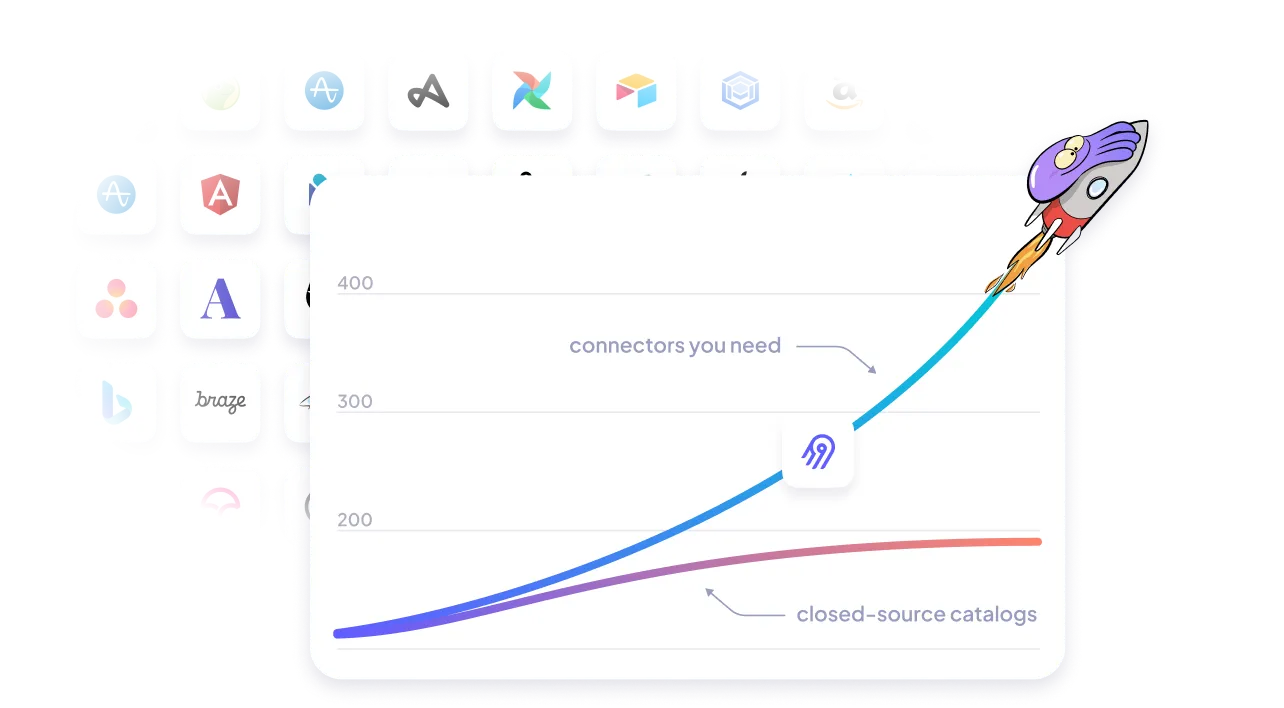
Cover your custom needs with our extensibility
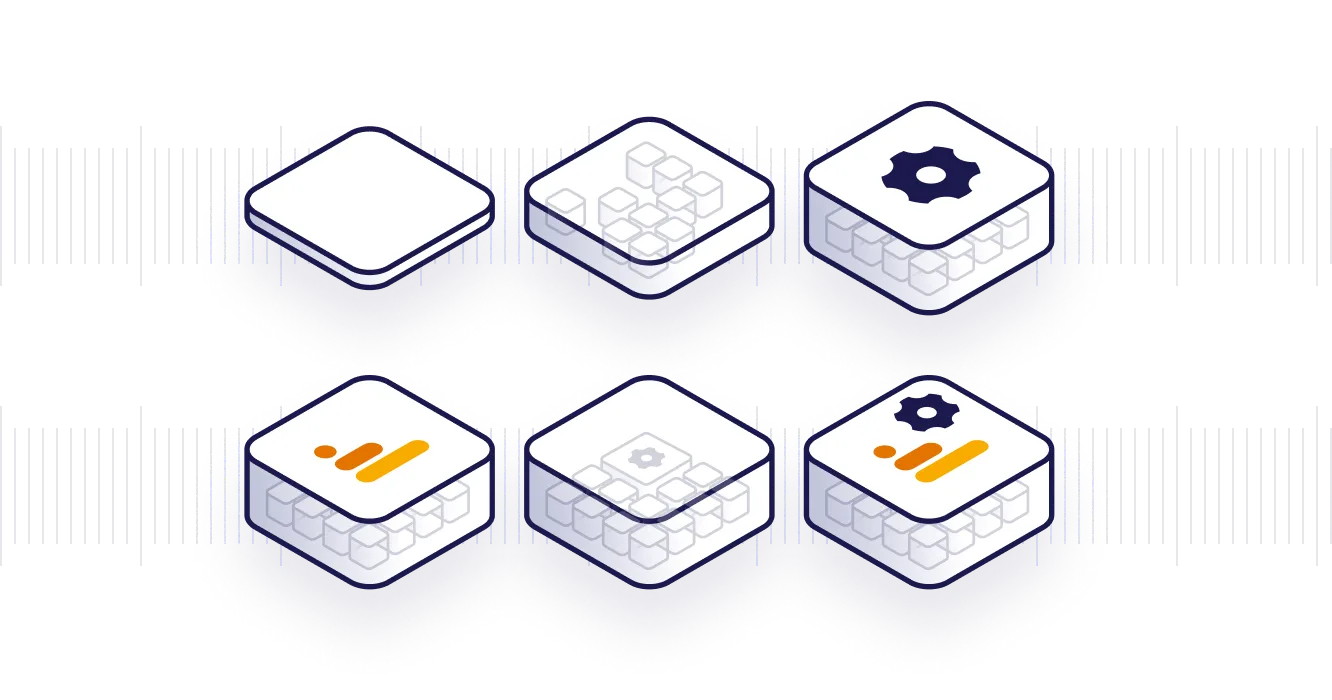
Free your time from maintaining connectors, with automation
- Automated schema change handling, data normalization and more
- Automated data transformation orchestration with our dbt integration
- Automated workflow with our Airflow, Dagster and Prefect integration
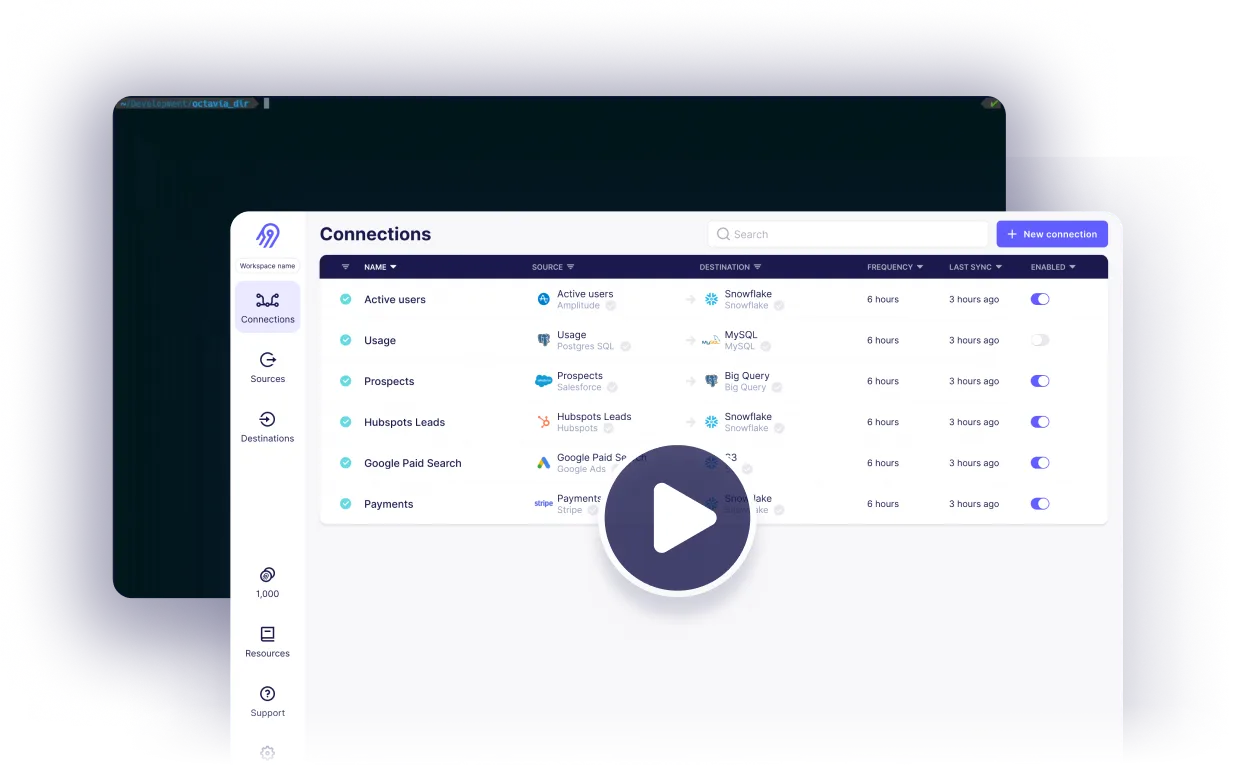
Reliability at every level



Ship more quickly with the only solution that fits ALL your needs.
As your tools and edge cases grow, you deserve an extensible and open ELT solution that eliminates the time you spend on building and maintaining data pipelines
Leverage the largest catalog of connectors

Cover your custom needs with our extensibility

Free your time from maintaining connectors, with automation
- Automated schema change handling, data normalization and more
- Automated data transformation orchestration with our dbt integration
- Automated workflow with our Airflow, Dagster and Prefect integration

Reliability at every level



Ship more quickly with the only solution that fits ALL your needs.
As your tools and edge cases grow, you deserve an extensible and open ELT solution that eliminates the time you spend on building and maintaining data pipelines
Leverage the largest catalog of connectors

Cover your custom needs with our extensibility

Free your time from maintaining connectors, with automation
- Automated schema change handling, data normalization and more
- Automated data transformation orchestration with our dbt integration
- Automated workflow with our Airflow, Dagster and Prefect integration

Reliability at every level



Move large volumes, fast.
Change Data Capture.
Security from source to destination.

We support the CDC methods your company needs
Log-based CDC



Timestamp-based CDC


Airbyte Open Source


Airbyte Cloud

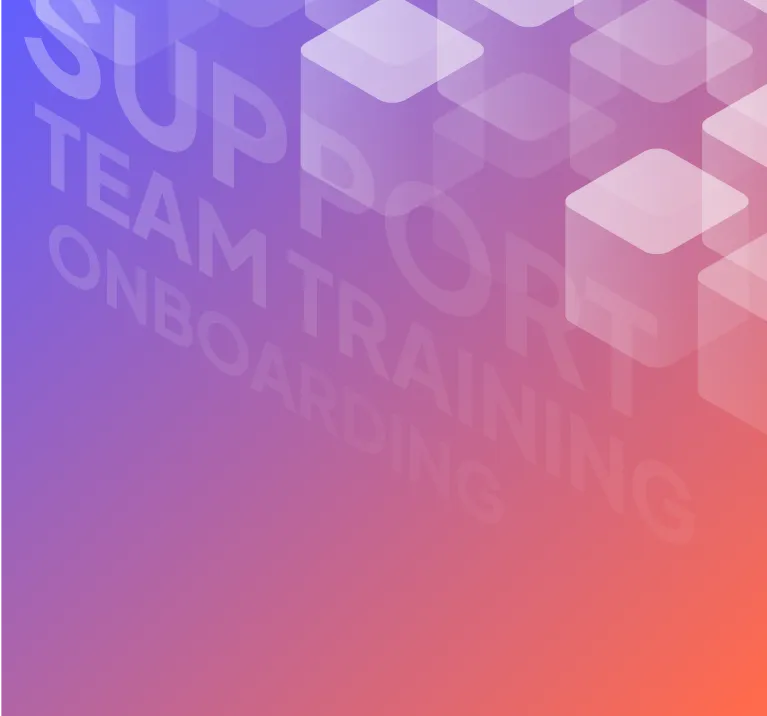
Airbyte Enterprise

Why choose Airbyte as the backbone of your data infrastructure?
Keep your data engineering costs in check
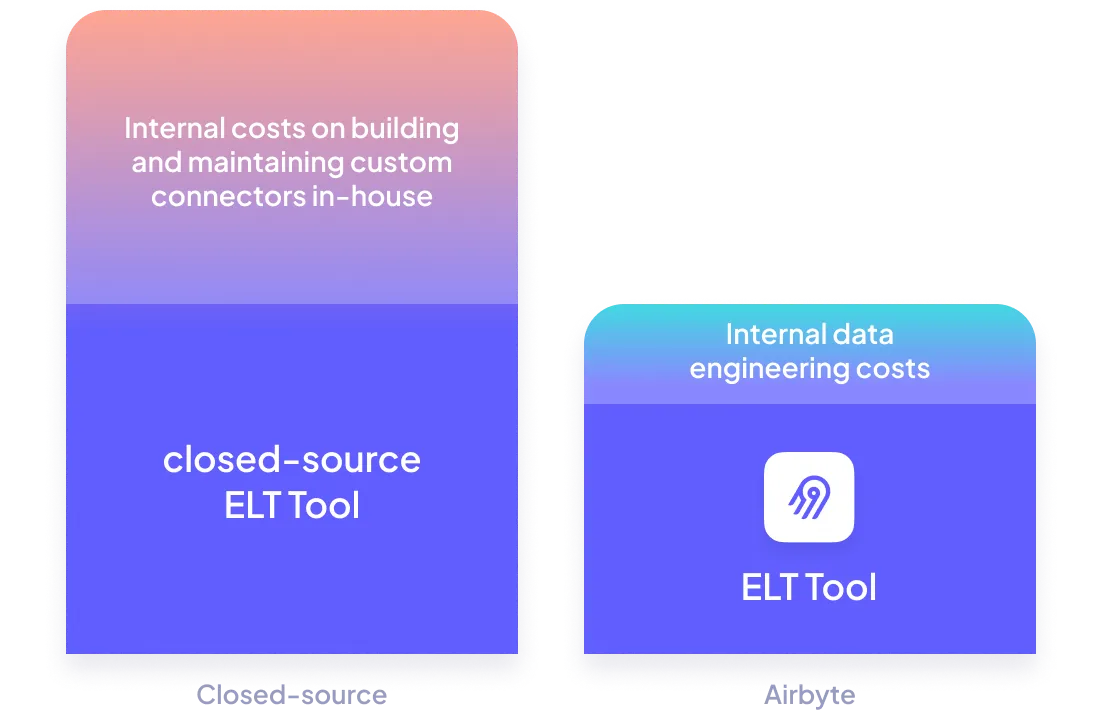
Get Airbyte hosted where you need it to be
- Airbyte Cloud: Have it hosted by us, with all the security you need (SOC2, ISO, GDPR, HIPAA Conduit).
- Airbyte Enterprise: Have it hosted within your own infrastructure, so your data and secrets never leave it.

White-glove enterprise-level support
Including for your Airbyte Open Source instance with our premium support.
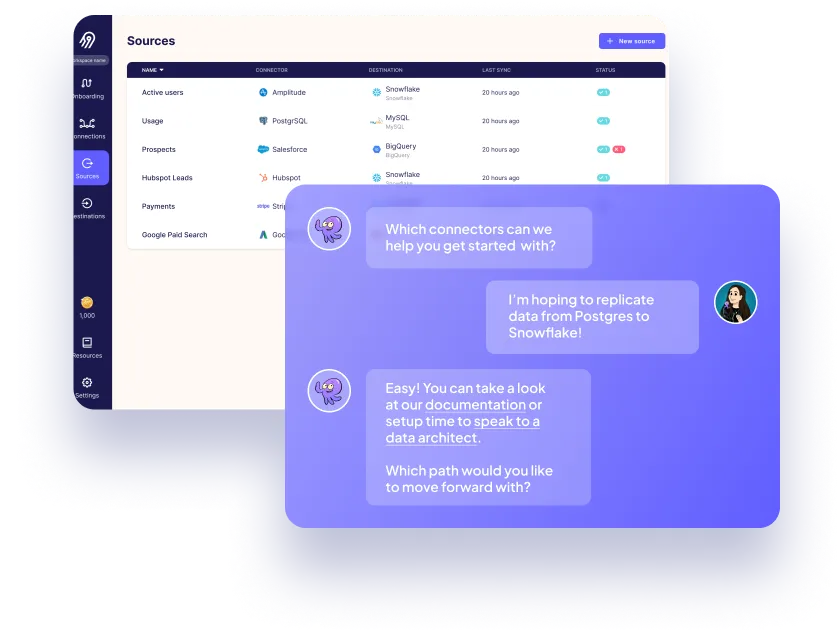
Airbyte supports a growing list of destinations, including cloud data warehouses, lakes, and databases.
Airbyte supports a growing list of destinations, including cloud data warehouses, lakes, and databases.
Airbyte supports a growing list of sources, including API tools, cloud data warehouses, lakes, databases, and files, or even custom sources you can build.



Fnatic, based out of London, is the world's leading esports organization, with a winning legacy of 16 years and counting in over 28 different titles, generating over 13m USD in prize money. Fnatic has an engaged follower base of 14m across their social media platforms and hundreds of millions of people watch their teams compete in League of Legends, CS:GO, Dota 2, Rainbow Six Siege, and many more titles every year.
Ready to get started?
FAQs
What is ETL?
ETL, an acronym for Extract, Transform, Load, is a vital data integration process. It involves extracting data from diverse sources, transforming it into a usable format, and loading it into a database, data warehouse or data lake. This process enables meaningful data analysis, enhancing business intelligence.
AppsFlyer is a mobile attribution and marketing analytics platform that helps businesses measure and optimize their mobile app marketing campaigns. It provides real-time data and insights on user acquisition, engagement, retention, and revenue, allowing businesses to make data-driven decisions to improve their app performance and ROI. AppsFlyer's platform integrates with over 5,000 partners, including ad networks, social media platforms, and analytics tools, to provide a comprehensive view of the entire mobile app marketing ecosystem. With its advanced fraud protection and privacy compliance features, AppsFlyer ensures that businesses can trust their data and protect their users' privacy.
AppsFlyer's API provides access to a wide range of data related to mobile app marketing and user engagement. The following are the categories of data that can be accessed through the API:
1. Attribution data: This includes information about the source of app installs, such as the ad network, campaign, and creative.
2. In-app events data: This includes data about user actions within the app, such as purchases, registrations, and other custom events.
3. Retargeting data: This includes data about users who have engaged with the app in the past and can be targeted with specific campaigns.
4. Audience data: This includes data about the characteristics of app users, such as demographics, interests, and behaviors.
5. Ad revenue data: This includes data about the revenue generated by ads within the app, such as impressions, clicks, and conversions.
6. Fraud prevention data: This includes data about potential fraudulent activity, such as fake installs or clicks.
7. Raw data: This includes all of the above data in its raw form, allowing for custom analysis and reporting.
What is ELT?
ELT, standing for Extract, Load, Transform, is a modern take on the traditional ETL data integration process. In ELT, data is first extracted from various sources, loaded directly into a data warehouse, and then transformed. This approach enhances data processing speed, analytical flexibility and autonomy.
Difference between ETL and ELT?
ETL and ELT are critical data integration strategies with key differences. ETL (Extract, Transform, Load) transforms data before loading, ideal for structured data. In contrast, ELT (Extract, Load, Transform) loads data before transformation, perfect for processing large, diverse data sets in modern data warehouses. ELT is becoming the new standard as it offers a lot more flexibility and autonomy to data analysts.
What is ETL?
ETL, an acronym for Extract, Transform, Load, is a vital data integration process. It involves extracting data from diverse sources, transforming it into a usable format, and loading it into a database, data warehouse or data lake. This process enables meaningful data analysis, enhancing business intelligence.
AppsFlyer is a mobile attribution and marketing analytics platform that helps businesses measure and optimize their mobile app marketing campaigns. It provides real-time data and insights on user acquisition, engagement, retention, and revenue, allowing businesses to make data-driven decisions to improve their app performance and ROI. AppsFlyer's platform integrates with over 5,000 partners, including ad networks, social media platforms, and analytics tools, to provide a comprehensive view of the entire mobile app marketing ecosystem. With its advanced fraud protection and privacy compliance features, AppsFlyer ensures that businesses can trust their data and protect their users' privacy.
AppsFlyer's API provides access to a wide range of data related to mobile app marketing and user engagement. The following are the categories of data that can be accessed through the API:
1. Attribution data: This includes information about the source of app installs, such as the ad network, campaign, and creative.
2. In-app events data: This includes data about user actions within the app, such as purchases, registrations, and other custom events.
3. Retargeting data: This includes data about users who have engaged with the app in the past and can be targeted with specific campaigns.
4. Audience data: This includes data about the characteristics of app users, such as demographics, interests, and behaviors.
5. Ad revenue data: This includes data about the revenue generated by ads within the app, such as impressions, clicks, and conversions.
6. Fraud prevention data: This includes data about potential fraudulent activity, such as fake installs or clicks.
7. Raw data: This includes all of the above data in its raw form, allowing for custom analysis and reporting.
What is ELT?
ELT, standing for Extract, Load, Transform, is a modern take on the traditional ETL data integration process. In ELT, data is first extracted from various sources, loaded directly into a data warehouse, and then transformed. This approach enhances data processing speed, analytical flexibility and autonomy.
Difference between ETL and ELT?
ETL and ELT are critical data integration strategies with key differences. ETL (Extract, Transform, Load) transforms data before loading, ideal for structured data. In contrast, ELT (Extract, Load, Transform) loads data before transformation, perfect for processing large, diverse data sets in modern data warehouses. ELT is becoming the new standard as it offers a lot more flexibility and autonomy to data analysts.
What is ETL?
ETL, an acronym for Extract, Transform, Load, is a vital data integration process. It involves extracting data from diverse sources, transforming it into a usable format, and loading it into a database, data warehouse or data lake. This process enables meaningful data analysis, enhancing business intelligence.
AppsFlyer is a mobile attribution and marketing analytics platform that helps businesses measure and optimize their mobile app marketing campaigns. It provides real-time data and insights on user acquisition, engagement, retention, and revenue, allowing businesses to make data-driven decisions to improve their app performance and ROI. AppsFlyer's platform integrates with over 5,000 partners, including ad networks, social media platforms, and analytics tools, to provide a comprehensive view of the entire mobile app marketing ecosystem. With its advanced fraud protection and privacy compliance features, AppsFlyer ensures that businesses can trust their data and protect their users' privacy.
AppsFlyer's API provides access to a wide range of data related to mobile app marketing and user engagement. The following are the categories of data that can be accessed through the API:
1. Attribution data: This includes information about the source of app installs, such as the ad network, campaign, and creative.
2. In-app events data: This includes data about user actions within the app, such as purchases, registrations, and other custom events.
3. Retargeting data: This includes data about users who have engaged with the app in the past and can be targeted with specific campaigns.
4. Audience data: This includes data about the characteristics of app users, such as demographics, interests, and behaviors.
5. Ad revenue data: This includes data about the revenue generated by ads within the app, such as impressions, clicks, and conversions.
6. Fraud prevention data: This includes data about potential fraudulent activity, such as fake installs or clicks.
7. Raw data: This includes all of the above data in its raw form, allowing for custom analysis and reporting.
1. First, navigate to the Airbyte dashboard and click on the "Sources" tab on the left-hand side of the screen.
2. Click on the "Add Source" button and select "AppsFlyer" from the list of available connectors.
3. Enter your AppsFlyer API token and select the desired data range for the connector to pull data from.
4. Choose the specific AppsFlyer app you want to connect to and select the desired data fields to be included in the data sync.
5. Test the connection to ensure that the connector is properly configured and able to pull data from the selected app.
6. Once the connection is successful, save the configuration and activate the connector to begin syncing data from AppsFlyer to Airbyte.
7. Monitor the data sync to ensure that it is running smoothly and troubleshoot any issues that may arise.
8. Use the synced data to gain insights into your app's performance and make data-driven decisions to improve user engagement and retention.
What is ELT?
ELT, standing for Extract, Load, Transform, is a modern take on the traditional ETL data integration process. In ELT, data is first extracted from various sources, loaded directly into a data warehouse, and then transformed. This approach enhances data processing speed, analytical flexibility and autonomy.
Difference between ETL and ELT?
ETL and ELT are critical data integration strategies with key differences. ETL (Extract, Transform, Load) transforms data before loading, ideal for structured data. In contrast, ELT (Extract, Load, Transform) loads data before transformation, perfect for processing large, diverse data sets in modern data warehouses. ELT is becoming the new standard as it offers a lot more flexibility and autonomy to data analysts.

































